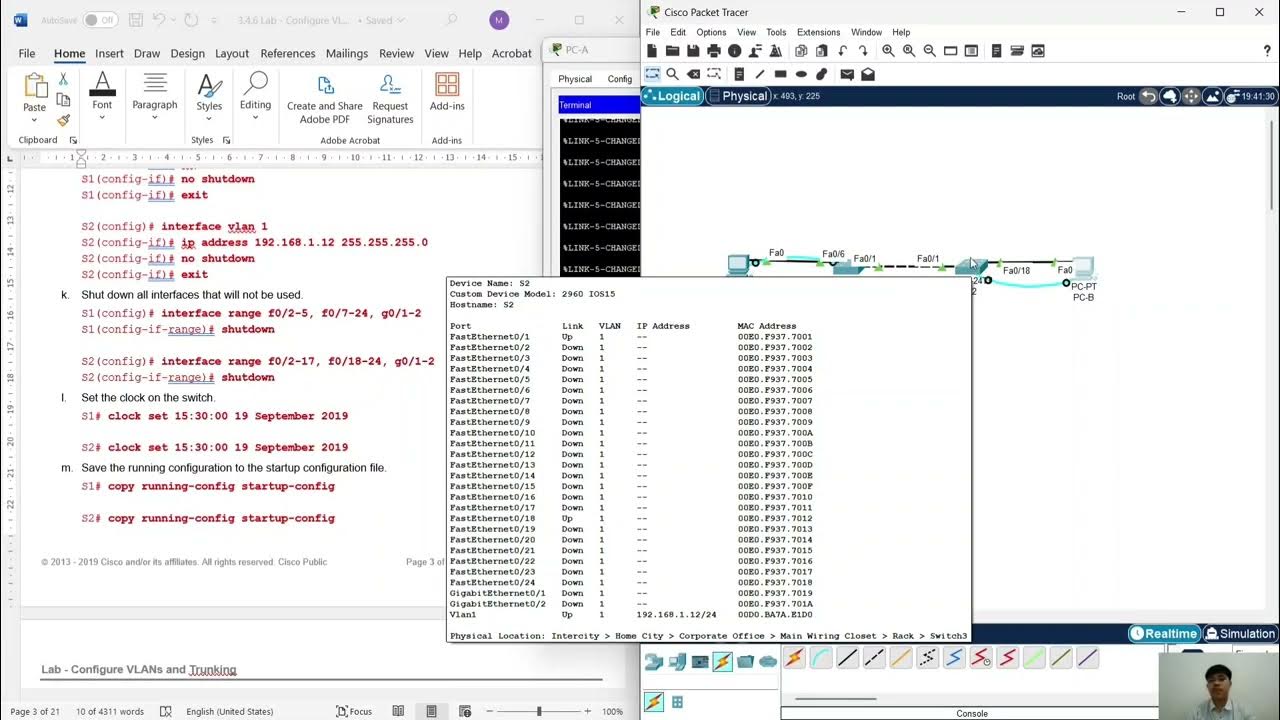VLANs and Trunking - N10-008 CompTIA Network+ : 2.3
Summary
TLDRThis script discusses the use of VLANs for network segmentation to enhance security and organization. It explains how VLANs allow logical separation within a single switch, reducing the need for multiple physical switches and wasted interfaces. The concept of VLAN trunking, or IEEE 802.1Q, is introduced as a method to extend VLANs across switches efficiently. The script also touches on the practical application of VLANs in managing devices like computers and VoIP phones on a single network cable, ensuring quality of service for voice communications.
Takeaways
- 🔒 **Network Segmentation**: Network administrators use VLANs to segment networks into different broadcast domains for enhanced security and organization.
- 🛠️ **Physical vs. Logical Separation**: Separating networks can be done physically with separate switches or logically within a single switch using VLANs.
- 🚫 **Isolation of Broadcast Domains**: VLANs prevent devices in one VLAN from communicating with devices in another, maintaining network isolation.
- 🌐 **Efficient Use of Resources**: Using VLANs within a single switch reduces the number of unused interfaces compared to having separate switches for each VLAN.
- 🔌 **Trunking VLANs**: VLAN trunking, or IEEE 802.1Q, allows multiple VLANs to be sent across a single link, simplifying the inter-switch connections.
- 🔗 **Scalability**: VLAN trunking is scalable and more efficient than using separate Ethernet cables for each VLAN, which would be impractical with a large number of VLANs.
- 🏷️ **VLAN Header**: An 802.1Q trunk adds a VLAN header to Ethernet frames to indicate the VLAN ID, allowing multiple VLANs to be distinguished on a single link.
- 📈 **VLAN Ranges**: VLANs are numbered in a range from 1 to 4094, with 0 and 4095 reserved, and are often divided into normal and extended ranges.
- 📞 **Voice and Data Integration**: VLANs can be used to segregate voice (VoIP) and data traffic on a single physical link, ensuring quality of service for voice communications.
- 🔄 **Inter-Switch Communication**: Devices on the same VLAN across different switches can communicate with each other through trunked links, maintaining VLAN integrity.
Q & A
Why do network administrators segment networks into different broadcast domains?
-Network administrators segment networks into different broadcast domains to enhance security features and to keep the network organized.
What is one way to segment a network into different broadcast domains?
-One way to segment a network is by using completely separate switches, each with its own broadcast domain.
What challenge arises from using separate switches for different broadcast domains?
-Using separate switches results in a lot of wasted interfaces, as many interfaces are powered and managed but are not connected to any devices.
How do VLANs help in reducing the challenge of wasted interfaces?
-VLANs allow for logical separation of networks within a single switch, thus reducing the need for multiple physical switches and minimizing wasted interfaces.
What is the IEEE 802.1Q standard and how does it relate to VLANs?
-The IEEE 802.1Q standard, also known as dot1Q, is an Ethernet trunking standard that allows multiple VLANs to be sent across a single connection, streamlining communication between switches.
How does VLAN trunking simplify the connection between switches with multiple VLANs?
-VLAN trunking simplifies connections by allowing all VLANs to be communicated across a single link, instead of requiring separate Ethernet cables for each VLAN.
What is the maximum number of VLANs that can be supported within a trunk connection?
-A trunk connection can support up to 4,094 VLANs, as the VLAN ID is 12 bits long.
What is the purpose of the VLAN header added to an Ethernet frame when it hits a trunk?
-The VLAN header, added when an Ethernet frame hits a trunk, contains information about which VLAN the data is associated with, allowing for proper routing and separation of traffic.
Why might a network administrator choose to separate voice and data traffic onto different VLANs?
-Separating voice and data traffic onto different VLANs ensures quality of service for voice communications by preventing data traffic from overwhelming the time-sensitive voice over IP connections.
How does the 802.1Q standard handle the configuration for a single network link used by both a computer and a phone?
-The 802.1Q standard allows for a single network link to be used by both a computer and a phone by designating each switch interface with both a data VLAN and a voice VLAN, enabling prioritization of voice traffic.
Outlines

Esta sección está disponible solo para usuarios con suscripción. Por favor, mejora tu plan para acceder a esta parte.
Mejorar ahoraMindmap

Esta sección está disponible solo para usuarios con suscripción. Por favor, mejora tu plan para acceder a esta parte.
Mejorar ahoraKeywords

Esta sección está disponible solo para usuarios con suscripción. Por favor, mejora tu plan para acceder a esta parte.
Mejorar ahoraHighlights

Esta sección está disponible solo para usuarios con suscripción. Por favor, mejora tu plan para acceder a esta parte.
Mejorar ahoraTranscripts

Esta sección está disponible solo para usuarios con suscripción. Por favor, mejora tu plan para acceder a esta parte.
Mejorar ahora5.0 / 5 (0 votes)






